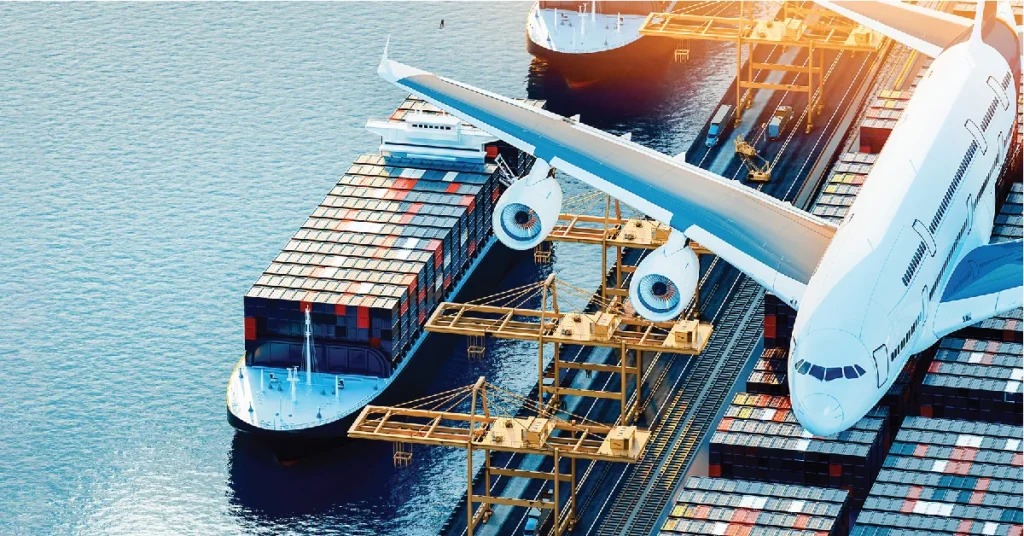Freight shipping has become a vital element of global trade, enabling the movement of large quantities of goods across the globe. The speed of freight shipping is closely tied to the mode of transport chosen. For instance, air freight offers the fastest delivery times, typically within 1 to 5 days for international shipments, while sea freight, though slower at 20 to 45 days, is more cost-effective for large-volume goods. Land freight, like trucking or rail, balances speed and cost with domestic shipments taking 1 to 7 days, depending on the distance.
Covering these vast distances involves pricing factors that can often be confusing. In this article, you’ll learn how the cost of freight shipping depends on a variety of factors, from the type of transport to shipment size, distance, and additional services. Understanding what influences freight shipping costs, both domestically and internationally, will help you plan more efficiently and avoid unexpected fees. We’ve broken down the key factors affecting costs and included tips to simplify the process.
How Much Does Freight Shipping Cost?
The cost of freight shipping varies. It is based on several factors which include:
- Mode of transport: Air Freight is usually costlier because of speed and urgency. Its rates vary from $1.50 to $4.50 per kilogram. These rates depend on the route. Sea Freight would be comparatively cheaper for the consignments moving in a large volume. In general, FCL will range somewhere between $500 to 3000 in US dollars, while for LCL it will be less. Land rates of Truck / Rail will depend upon mileage and can be quoted anywhere between $0.50 to $2.50 per mile.
- Shipment Size and Weight: Larger or heavier shipments are more expensive.
- Distance: Longer ship routes cost more.
- Customs, Duties, and Taxes: Additional charges can vary on shipment depending on the origin, destination, and commodities.
- Seasonality and Demand: Costs are high during peak seasons or when the demand is higher.
How to Calculate Freight Shipping Costs

Calculating the freight shipment cost can vary from one company to another depending on their own charges. But there is a formula that can make it easier for you to calculate your shipment cost. The formula is;
Freight Shipping Cost = BR + DC + WC + AC – D
Where
- Base Rate (BR): The initial cost set by the carrier for the service, based on the type of freight.
- Distance Charge (DC): Cost per mile or kilometer, calculated by multiplying the distance the freight needs to travel by the carrier’s rate per distance unit.
- Weight Charge (WC): Cost based on the weight of the shipment, typically determined by multiplying the weight (in pounds or kilograms) by the rate per unit weight.
- Accessorial Charges (AC): Additional fees that may apply for special services such as liftgate service, inside delivery, or hazardous material handling.
- Discounts (D): Any applicable discounts based on volume shipping, loyalty programs, or special arrangements with the carrier.
Freight Shipping Costs on eBay
Freight shipping costs on eBay can be various. They depend on these factors
- Flat-Rate Shipping: Some sellers set an overhead cost, which might include packaging, handling, and shipping, typically listed in the item’s description.
- Freight Quote: The sellers may demand the buyers to ask for a custom freight shipping quote if the items are large or heavy. The rates will depend upon the buyer’s location and the specifics of the shipment.
In general, freight shipping is very costly for bigger-ticket items such as furniture or machinery, usually in the range of $100 to several hundred dollars at times.
How Your Shipment Dimensions and Weight Affect Freight Costs

Density determines the dimensions and weight of your shipment. High density, low shipping cost. This affects freight classification.
How to Calculate Freight Density
- Measure the length, width, and height of the shipment in inches, including packaging.
- Multiply the measurements to get total cubic inches.
- Divide the cubic inches by 1,728 to get cubic feet.
- Divide the weight (in pounds) by the cubic feet to get density (in pounds per cubic foot).
Freight Shipping Costs and Pricing
Freight costs consider various factors, including:
- Freight Weight, Dimensions, or Volume: Legal hauling limits and space usage are affected by the dimensions and weight of the shipment.
- Shipping Origin and Destination: Because of fuel consumption and operation cost rate of shipment is affected by distance. Moreover, accurate ZIP codes are crucial in this process.
- Freight Class and Density: The density and class of freight are determined by correct classification. It also has an impact on the rates.
- Type of Goods: The nature of the goods may require specialized equipment or handling.
- Economic Conditions: Fuel prices, seasonal demand, and market conditions also have a huge impact on shipment rates.
Understanding Freight Shipping Quotes
Since information drives accuracy, make sure to provide as much information as possible when securing quotes for freight shipping. Here’s the quotation process:
- Detailed Shipment Information: Give this information in as much detail as possible, the dimension, weight, and type of cargo. This would avoid unexpected charges so that what you spend lands up in the quote.
- Destination and Origin: Always provide the exact address with a ZIP code because shipping charges are location-based. Also, there will be different charges in the urban areas as compared to the rural ones because this has something to do with accessibility and service levels.
- Service Requirements: Telling beforehand about any special requirements, such as temperature control, hazardous materials handling, or liftgate services is crucial. All these do have an impact on the overall cost.
- Frequency and Volume: As a regular shipper, negotiate discounts for higher frequency or volume shipments. Most carriers give discounted rates for bulk shipping or under-contract agreements.
- Carrier Options: Make sure to compare quotes from multiple carriers. Carriers will have different services, different speeds, and different cost structures. Comparing them will enable you to decide which one works best for you in terms of cost and service quality.
Factors Affecting Freight Shipping Costs in Different Regions

Shipping freight can cost pretty much anything depending on the region. This can be attributed to regional factors in the following ways:
- Domestic vs. International Shipping: While the delivery charges are generally lower for domestic shipping because there are fewer regulations and less distance, international deliveries might also incur other additional costs such as customs duty, taxes, and import/export charges.
- Regional Differences: Shipment costs will be relatively cheaper in areas that are well developed, such as big ports or transport hubs, as there is competition and efficiency provided. For remote or less serviced regions with poor serviceability and distances, costs are more expensive.
- Local Regulations: Regions vary in their laws that define the shipping charges. Some regions require special permits and clearances for certain items, which adds to the cost when shipping.
How to Save on Freight Shipping Costs
Freight shipping is a process that can cost you some good sums. TEU Global provides details regarding how to reduce freight shipping costs. Here are some strategies to help reduce freight shipping costs:
- Optimize Shipment Packaging: Proper packaging reduces the size and weight of the shipment which might reduce the cost as well. Use the most efficient package possible to not have extra space paid for or excess weight.
- Negotiate Rates: If you are shipping a high volume, negotiate your rates with carriers. Most carriers will adjust their rate for you based on volume or a long-term contract.
- Use Freight Brokers: Freight brokers will allow you to tap into a network and expertise to find the right rate and service. They may be able to open up opportunities for discounted rates, and further negotiate on your behalf.
- Consolidate Shipments: It is possible to get the lowest overall cost when you group several shipments. LTL shipping thrives with the concept of consolidation wherein shared space by other shipments lowers costs per shipment.
- Plan Ahead: Do not ship out at the last minute. Plan to get better rates and save expenditures on overnight shipping.
Final Thoughts
Understanding freight shipping costs is essential for managing your budget effectively, whether you are a company shipping commodities or an individual who happens to buy huge items. By considering factors such as the mode of transport, shipment size and weight, distance, and additional charges, you can gain a clearer picture of what influences pricing.
Additionally, factors like peak season surcharges, fuel costs, and freight class are also important. To achieve the most accurate estimate, make sure to provide all the shipment details and compare quotes from different providers. You will be able to easily navigate through the obstacles and complications related to freight shipping and avoid other hidden costs through this.



